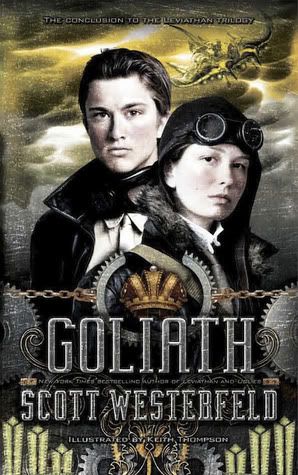Goliath by Scott Westerfeld, illustrated by Keith Thompson
Summary:
Deryn and Alek continue their trek eastward on the Leviathan as the world falls
farther and farther into war. But the Leviathan might have the solution to the
end of the war, along the way they pick up renowned scientist Telsa who claims
to have a weapon that could level cities at a glance, a weapon that force
anyone to stop all the fighting and what Alek is banking on. Deryn and the other Darwinists have their doubts however and Deryn is finding that it's becoming harder and harder to hide her true identity and the more involved she becomes in the world's affairs the more dangerous it becomes to reveal it.
The
Good: Westerfeld continues to expand his world by showing
off Japan and the Americas and their blends of technologies and ideologies was
nice*. Also nice was some characters from
the second book reappearing, I’ve grown rather used to trilogies which have
different expanded casts in every book that this was a nice surprise. The book actually balanced a large cast very well with even more factions being introduced and no one felt like a flat, background character. This was helped in part by the pacing, a lot happens in the story and the Leviathan covers even more ground than the first two books and it never feels like one area or place drags on too long or is breezed by too quickly, everything flowed very well. Finally,
fans should go to Westerfeld’s blog and read the extra chapter set after
the series which was quite fun.
The
Bad: While the ending wasn’t bad and was what I had
been expecting, since I knew the actual history Goliath was borrowing, so it wasn’t quite as satisfying as I had
hoped. Again, it’s a reasonable ending, makes sense (hence I had predicted
something rather close), it just didn’t hit the right emotional notes with me (not the very end end, the whole ending in general).
I was also a bit underwhelmed with what the Lorises were really supposed to be, it does sound like Doctor Barlow broke a major rule while creating them but I
still fail to see why they were ever supposed to be important to the conflict. Overall, the ending was a bit underwhelming and played out fairly close to what I predicted and, as someone who likes tricky plots I found it a bit unsatisfying.
The
Art: The art continues to be stunning and while I
felt like some of the crowd scenes weren’t quite as detailed as the ones from
the second book but the art has noticeably improved from the first book (which
wasn’t bad, it simply got even better). The art continues to be the easiest way
for me to promote the book to friends (it’s much easier to flash a few pictures
from a book rather than find time to make someone read a few passages that they
hopefully like) and it’s the biggest reason that this book is on my to-buy list (and on a similar note I'm excited for the companion guide which will have even more illustrations in it, coming out later this year I believe).
Despite the ending not being quite as interesting as I hoped this was still a very strong installment to end on and I'm looking forward to whatever Westerfeld writes next. Actually, come to think of it I don't think I've heard of what his next project is (other than the pre-Uglies graphic novels and the companion book for this), hope it's interesting!
*although I question that the [American] South, the god-fearing South
which today still has issues with “moral debates” today (I mean, for god's sake my state votes on a constitutional amendment against gay marriage even though it's already illegal) being the half that had
fabricated beasties, I can see where he was going with the North and their
machines but it didn’t quite work for me, an East-West split with an industrialized East and a fabricated West would have made much more sense.
